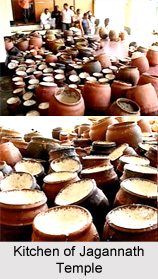 Kitchen of Lord Jagannath Temple is considered to be the largest kitchen in India. According to legend all the food that is cooked in the temple kitchen of Jagannath Temple is supervised by Goddess Lakshmi.
Kitchen of Lord Jagannath Temple is considered to be the largest kitchen in India. According to legend all the food that is cooked in the temple kitchen of Jagannath Temple is supervised by Goddess Lakshmi.
Structure of Kitchen of Lord Jagannath Temple
The length of the kitchen of Lord Jagannath Temple is 150 feet, breadth is 100 feet and height is about 20 feet. It consists of 32 rooms with 250 earthen ovens within these. Around 600 cooks (Suaras) and 400 assistants serve here everyday for preparing Lord`s food. There are three types of hearths in the kitchen of Srimandir such as Anna Chuli, Ahia Chuli and Pitha Chuli. The dimension of hearths where rice is prepared are 4` x 2.5` x 2`. The rectangular space created between two rice hearths is called Ahia. All types of Dal and Curry items are cooked in Ahia Chuli. There are only ten numbers of Pitha Chuli in the temple kitchen which are made of cement. The fire of this kitchen is known as Vaishnava Agni, because it is the fire in the kitchen of Lord Jagannath and used to serve Vishnu Himself. It is never put out.
Equipments of Kitchen of Lord Jagannath Temple
The kitchen comprises 780 ovens all constructed on raised earthen platforms. The construction of an oven is such that it has a bigger fire place in the centre and six small fire places all around it. Three big earthen pots called Baihandi are set one upon the other in the central oven and six small pots called Kudua are set around the big pot. By this arrangement the foods cooked one time in these nine pots is sufficient for one meal of about 200 adult persons. Except salt and turmeric powder no spices are added to the items which are cooked for the deities present in the temple.
Cooks of Lord Jagannath Temple
Temple kitchen of the Jaganath temple is as sacred as the Jagannath temple itself. It is an important aspect of the sacred complex. The kitchen section lies to the south of the temple and except the cooks (Suars and Mahasuars) on one else is allowed to enter the area except during the Gundicha Jatra. Different categories of Sebakas and even Mathadharis are intimately associated with the kitchen and any lack of cooperation and coordination among them results in dislocations of services and disorganization in the whole system.
Chariots of Lord Jagannath Temple
When the deities of the Jagannath Temple of Puri are carried on their respective cars during car festival to the Gundichaghar where they are worshipped for a period of nine days the kitchen section which remains out of use during this period is thrown open to the public to go round and see. There is a separate kitchen section at the Gundichaghar where the Bhogs are cooked and offered to the deities. It is during this period that the kitchen at the Gundichaghar is prohibited to the public.
Homa in Lord Jagannth Temple
Everyday before anything is cooked a ritual (Homa) is performed in which the god of fire is worshipped and the sacred fire is set in each oven. The time for the performance of this ritual is around 8.30 am after which the Bhogs are prepared in the kitchen according to the daily routine of rituals (Dainika Niti). Broadly the Bhogs can be classified into two types-dry food (Sukhuli) and cooked food (Sankhudi).
Bhogs in Kitchen of Lord Jagannath Temple
No food cooked outside the temple kitchen is offered to the deities. All the bhogs (divine food offerings) offered by different maths and sebakas are invariably cooked in the temple kitchen and therefore, they have chullas exclusive to themselves in the temple kitchen for cooking their respective Bhogs. For example, the maths such as Emar, Sankarananda, Gangamata, Kausalya Das, Sriram Das, Lakshmibhadra, Panjabi, Baula, Jagannath Ballava, Raghava Das, Radhakanta, Mahiprakash, Odiya, Bada Jhadu, Trimali, Achari Uttarparswa and a few other maths have each ovens of their own in the kitchen. No one except the Suar sebakas cook the Bhog in the temple kitchen, and therefore the Mathadharis supply rice, dal (pulses), vegetables, wheat, sugar, and all other foodstuffs which are required for the preparation of their Bhogs to the Suars who cook them in the temple kitchen. After the Bhog is offered to the deities the Mahaprasad is supplied to the mathas. The bhogs are cooked in new red-burnt earthen pots which are supplied by the potters and the water that is used for cooking is drawn from the two wells that are present in the temple kitchen with the names of Ganga and Jamuna. The entire process of cooking is done in the temple kitchen following all the rituals mentioned in the Hindu Scriptures.





















